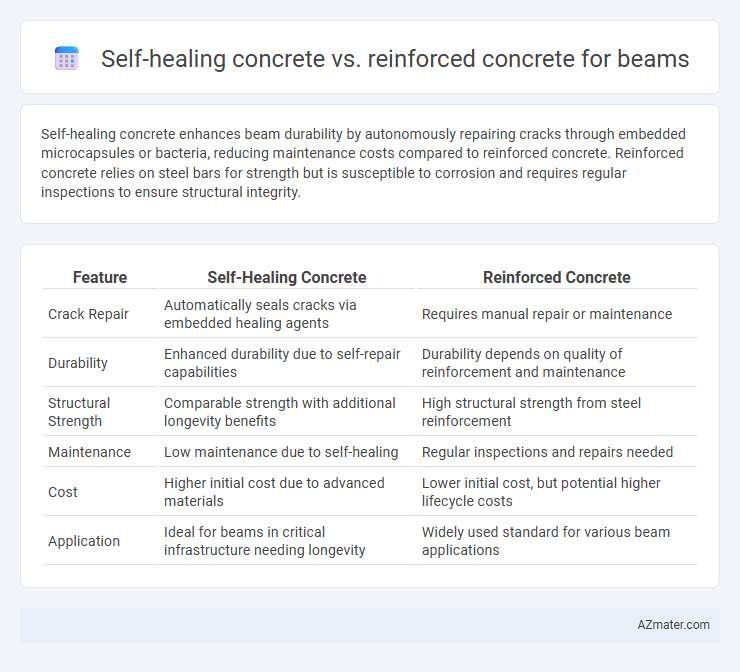Self-healing concrete enhances beam durability by autonomously repairing cracks through embedded microcapsules or bacteria, reducing maintenance costs compared to reinforced concrete. Reinforced concrete relies on steel bars for strength but is susceptible to corrosion and requires regular inspections to ensure structural integrity.
Table of Comparison
| Feature | Self-Healing Concrete | Reinforced Concrete |
|---|---|---|
| Crack Repair | Automatically seals cracks via embedded healing agents | Requires manual repair or maintenance |
| Durability | Enhanced durability due to self-repair capabilities | Durability depends on quality of reinforcement and maintenance |
| Structural Strength | Comparable strength with additional longevity benefits | High structural strength from steel reinforcement |
| Maintenance | Low maintenance due to self-healing | Regular inspections and repairs needed |
| Cost | Higher initial cost due to advanced materials | Lower initial cost, but potential higher lifecycle costs |
| Application | Ideal for beams in critical infrastructure needing longevity | Widely used standard for various beam applications |
Introduction to Self-Healing Concrete and Reinforced Concrete
Self-healing concrete incorporates microcapsules or bacteria that activate to seal cracks autonomously, enhancing durability and reducing maintenance costs in beam structures. Reinforced concrete combines concrete with steel reinforcement bars to provide tensile strength and structural integrity, making it a widely used material in beam construction. While reinforced concrete relies on external intervention for crack repair, self-healing concrete offers an innovative solution by automatically restoring material integrity.
Material Composition and Structural Properties
Self-healing concrete incorporates microcapsules or bacteria that trigger crack repair, enhancing durability and reducing maintenance compared to traditional reinforced concrete composed of cement, aggregates, and steel rebars for tensile strength. The bacterial or capsule agents in self-healing concrete actively close micro-cracks, improving crack resistance and extending structure lifespan, whereas reinforced concrete relies on steel reinforcement to manage tensile stresses but remains vulnerable to crack propagation and corrosion. Materially, self-healing concrete blends standard cementitious components with healing agents, offering improved structural resilience, whereas reinforced concrete depends heavily on steel reinforcement for load-bearing capacity and toughness in beam applications.
Mechanisms of Crack Management
Self-healing concrete utilizes encapsulated healing agents or bacteria that activate upon crack formation, filling and sealing microcracks autonomously to prevent water ingress and structural deterioration. Reinforced concrete employs steel rebars to distribute tensile stresses, controlling crack width and propagation but requires external maintenance to manage crack healing. The self-healing mechanism enhances durability and reduces maintenance by internally repairing cracks, whereas reinforced concrete relies primarily on mechanical support and periodic inspections for crack management.
Durability and Longevity of Beam Structures
Self-healing concrete enhances beam durability by autonomously sealing micro-cracks through embedded healing agents, significantly reducing water ingress and corrosion risks in reinforcements, thereby extending the structural lifespan. Reinforced concrete beams rely on traditional steel reinforcements vulnerable to corrosion, which can compromise durability and require maintenance or repairs over time. Incorporating self-healing mechanisms in concrete beams improves longevity by minimizing crack propagation and deterioration, offering superior performance compared to conventional reinforced concrete in harsh environmental conditions.
Load-Bearing Capacity and Flexural Strength
Self-healing concrete enhances load-bearing capacity and flexural strength in beams by autonomously repairing micro-cracks, reducing the risk of structural failure and prolonging service life. Reinforced concrete relies on steel reinforcement to carry tensile stresses but remains vulnerable to crack propagation and corrosion, which can compromise load-bearing performance over time. Advances in self-healing technologies improve durability and maintain flexural strength more effectively than conventional reinforced concrete under cyclic loading conditions.
Maintenance and Repair Requirements
Self-healing concrete significantly reduces maintenance and repair requirements for beams by autonomously sealing cracks, thereby preventing water ingress and corrosion of reinforcement. In contrast, reinforced concrete requires regular inspections and timely repairs to address cracks and prevent structural deterioration caused by steel corrosion. The self-healing properties result in lower long-term maintenance costs and enhanced durability compared to traditional reinforced concrete beams.
Cost Analysis: Initial Investment vs. Lifecycle Savings
Self-healing concrete for beams requires higher initial investment due to advanced materials and technology costs compared to traditional reinforced concrete. Lifecycle savings emerge from reduced maintenance, repair frequency, and extended service life, potentially lowering total ownership costs over decades. Reinforced concrete offers lower upfront costs but demands more frequent repairs and maintenance, increasing lifecycle expenses significantly.
Environmental Impact and Sustainability Considerations
Self-healing concrete significantly reduces the environmental impact of beams by minimizing the need for repairs and extending structural lifespan, thereby lowering resource consumption and carbon emissions associated with maintenance. Reinforced concrete, while strong and widely used, often leads to higher environmental costs due to steel production and frequent repairs triggered by corrosion-induced cracking. Sustainability considerations favor self-healing concrete as it enhances durability and reduces waste, aligning with green building practices and lifecycle carbon reduction goals.
Real-World Applications and Case Studies
Self-healing concrete has been successfully applied in infrastructure projects such as highways and bridges to enhance durability by autonomously repairing microcracks, reducing maintenance costs and extending service life compared to traditional reinforced concrete beams. Case studies from the Netherlands and Japan demonstrate that self-healing concrete beams significantly lower water ingress and corrosion risks, which are common failure points in reinforced concrete structures exposed to harsh environmental conditions. Real-world applications highlight improved sustainability and resilience, making self-healing concrete a promising alternative for future load-bearing beam construction in civil engineering.
Future Prospects and Industry Adoption
Self-healing concrete for beams offers promising future prospects by significantly reducing maintenance costs and extending structural lifespan through autonomous crack repair using embedded microcapsules or bacteria-based agents. Reinforced concrete remains widely adopted in the industry due to its proven strength and versatility, but the integration of self-healing technologies is gradually being explored to enhance durability and sustainability standards in infrastructure projects. Ongoing research and pilot implementations indicate a growing shift towards hybrid beams combining traditional reinforcement with self-healing properties, signaling an evolution in construction materials toward smarter, longer-lasting solutions.

Infographic: Self-healing concrete vs Reinforced concrete for Beam
 azmater.com
azmater.com